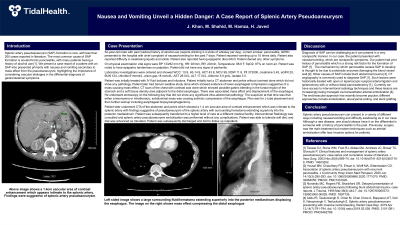Tuesday Poster Session
Category: Biliary/Pancreas
P3620 - Nausea and Vomiting Unveil a Hidden Danger: A Case Report on Splenic Artery Pseudoaneurysm
Tuesday, October 29, 2024
10:30 AM - 4:00 PM ET
Location: Exhibit Hall E

Has Audio
- Jk
Junaid khan, MD
Tidal Health
Salisbury, MD
Presenting Author(s)
Junaid khan, MD, Mubasshar Shahid, MD, Mohammad Hamza, MD, Hafiz Javed, MD
Tidal Health, Salisbury, MD
Introduction: Splenic artery pseudoaneurysm (SAP) formation is a rare presentation, with fewer than 200 cases reported in the literature. The most common cause of SAP formation is acute or chronic pancreatitis, with many patients having a history of alcohol use. We present a case of a patient with an SAP who presented primarily with nausea and vomiting secondary to the mass effect from the pseudoaneurysm, highlighting the importance of considering vascular etiologies in the differential diagnosis of gastrointestinal symptoms.
Case Description/Methods: The patient is a 52-year-old male with a past medical history of alcohol use disorder, pancreatitis, and gastroesophageal disease (GERD) who presented to the ER for evaluation of nausea and vomiting. He reported 10-15 episodes of vomiting per day over the past week. Initially, the patient was started on a clear liquid diet, which he could not tolerate. He subsequently underwent a barium swallow for further evaluation, which showed a paraesophageal hernia and mass effect on the distal esophagus, which was followed by upper GI endoscopy, which revealed LA classification grade D reflux esophagitis with no bleeding, as well as a normal gastric fundus, body, and antrum. Post-EGD, the patient underwent a CT angiography of the abdomen and pelvis with contrast, which showed a 1.4 cm saccular area of contrast enhancement near the splenic artery and a large surrounding fluid/hematoma extending superiorly into the posterior mediastinum, displacing the esophagus and suggesting a pseudoaneurysm of the splenic artery. The case was discussed with cardiothoracic, vascular, and general surgery teams, and the patient was subsequently transferred to a tertiary care facility, where he underwent splenic artery pseudoaneurysm embolization.
Discussion: Diagnosis of SAP can be challenging as it can present in a very nonspecific manner. In our case, the patient presented with nausea and vomiting, which are nonspecific symptoms. Our patient has a history of pancreatitis along with alcohol use disorder, both of which are associated with the formation of SAP. CT angiography is commonly used to diagnose SAP. Regarding treatment, such lesions were previously managed surgically via open surgical resection, ligation, partial pancreatectomy, or splenectomy. The endovascular approach has recently become popular; different techniques include embolization, aneurysmal coiling, and stent grafting.
Disclosures:
Junaid khan, MD, Mubasshar Shahid, MD, Mohammad Hamza, MD, Hafiz Javed, MD. P3620 - Nausea and Vomiting Unveil a Hidden Danger: A Case Report on Splenic Artery Pseudoaneurysm, ACG 2024 Annual Scientific Meeting Abstracts. Philadelphia, PA: American College of Gastroenterology.
Tidal Health, Salisbury, MD
Introduction: Splenic artery pseudoaneurysm (SAP) formation is a rare presentation, with fewer than 200 cases reported in the literature. The most common cause of SAP formation is acute or chronic pancreatitis, with many patients having a history of alcohol use. We present a case of a patient with an SAP who presented primarily with nausea and vomiting secondary to the mass effect from the pseudoaneurysm, highlighting the importance of considering vascular etiologies in the differential diagnosis of gastrointestinal symptoms.
Case Description/Methods: The patient is a 52-year-old male with a past medical history of alcohol use disorder, pancreatitis, and gastroesophageal disease (GERD) who presented to the ER for evaluation of nausea and vomiting. He reported 10-15 episodes of vomiting per day over the past week. Initially, the patient was started on a clear liquid diet, which he could not tolerate. He subsequently underwent a barium swallow for further evaluation, which showed a paraesophageal hernia and mass effect on the distal esophagus, which was followed by upper GI endoscopy, which revealed LA classification grade D reflux esophagitis with no bleeding, as well as a normal gastric fundus, body, and antrum. Post-EGD, the patient underwent a CT angiography of the abdomen and pelvis with contrast, which showed a 1.4 cm saccular area of contrast enhancement near the splenic artery and a large surrounding fluid/hematoma extending superiorly into the posterior mediastinum, displacing the esophagus and suggesting a pseudoaneurysm of the splenic artery. The case was discussed with cardiothoracic, vascular, and general surgery teams, and the patient was subsequently transferred to a tertiary care facility, where he underwent splenic artery pseudoaneurysm embolization.
Discussion: Diagnosis of SAP can be challenging as it can present in a very nonspecific manner. In our case, the patient presented with nausea and vomiting, which are nonspecific symptoms. Our patient has a history of pancreatitis along with alcohol use disorder, both of which are associated with the formation of SAP. CT angiography is commonly used to diagnose SAP. Regarding treatment, such lesions were previously managed surgically via open surgical resection, ligation, partial pancreatectomy, or splenectomy. The endovascular approach has recently become popular; different techniques include embolization, aneurysmal coiling, and stent grafting.
Disclosures:
Junaid khan indicated no relevant financial relationships.
Mubasshar Shahid indicated no relevant financial relationships.
Mohammad Hamza indicated no relevant financial relationships.
Hafiz Javed indicated no relevant financial relationships.
Junaid khan, MD, Mubasshar Shahid, MD, Mohammad Hamza, MD, Hafiz Javed, MD. P3620 - Nausea and Vomiting Unveil a Hidden Danger: A Case Report on Splenic Artery Pseudoaneurysm, ACG 2024 Annual Scientific Meeting Abstracts. Philadelphia, PA: American College of Gastroenterology.

